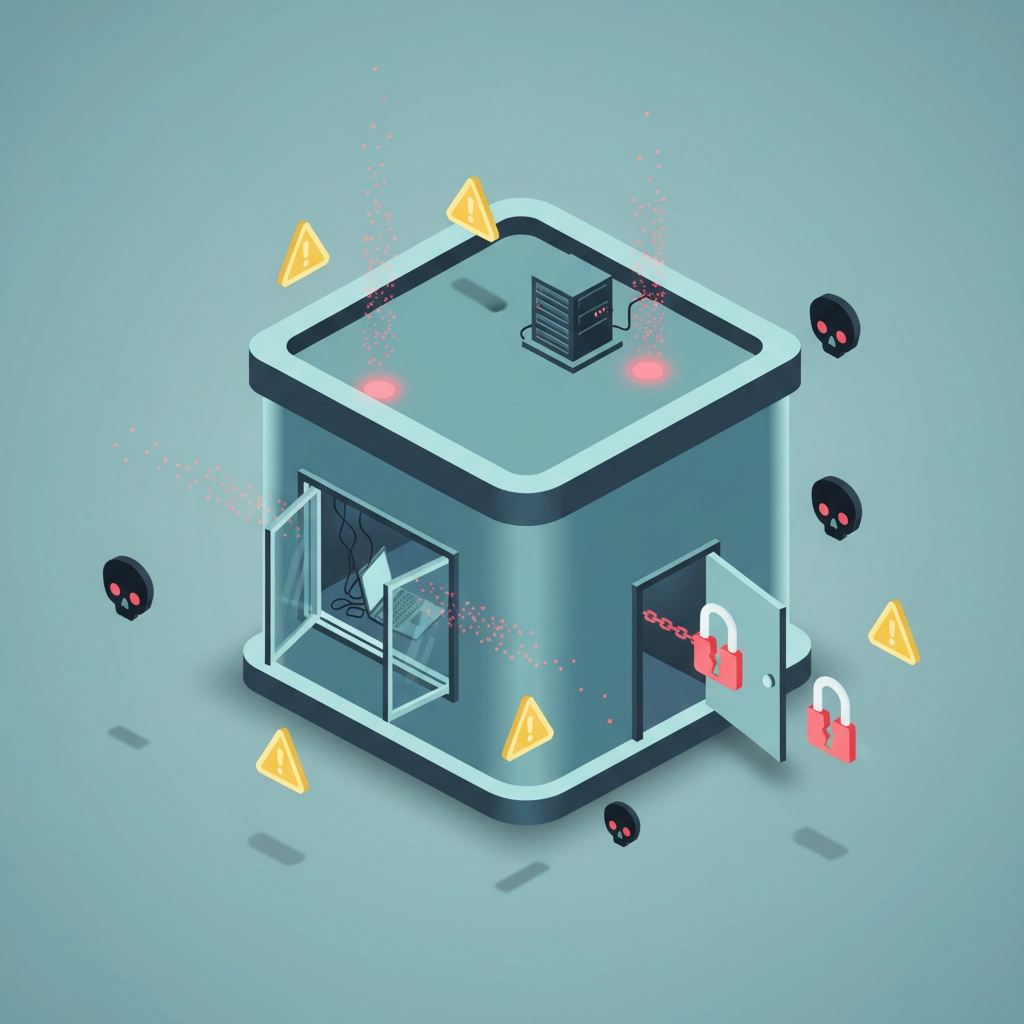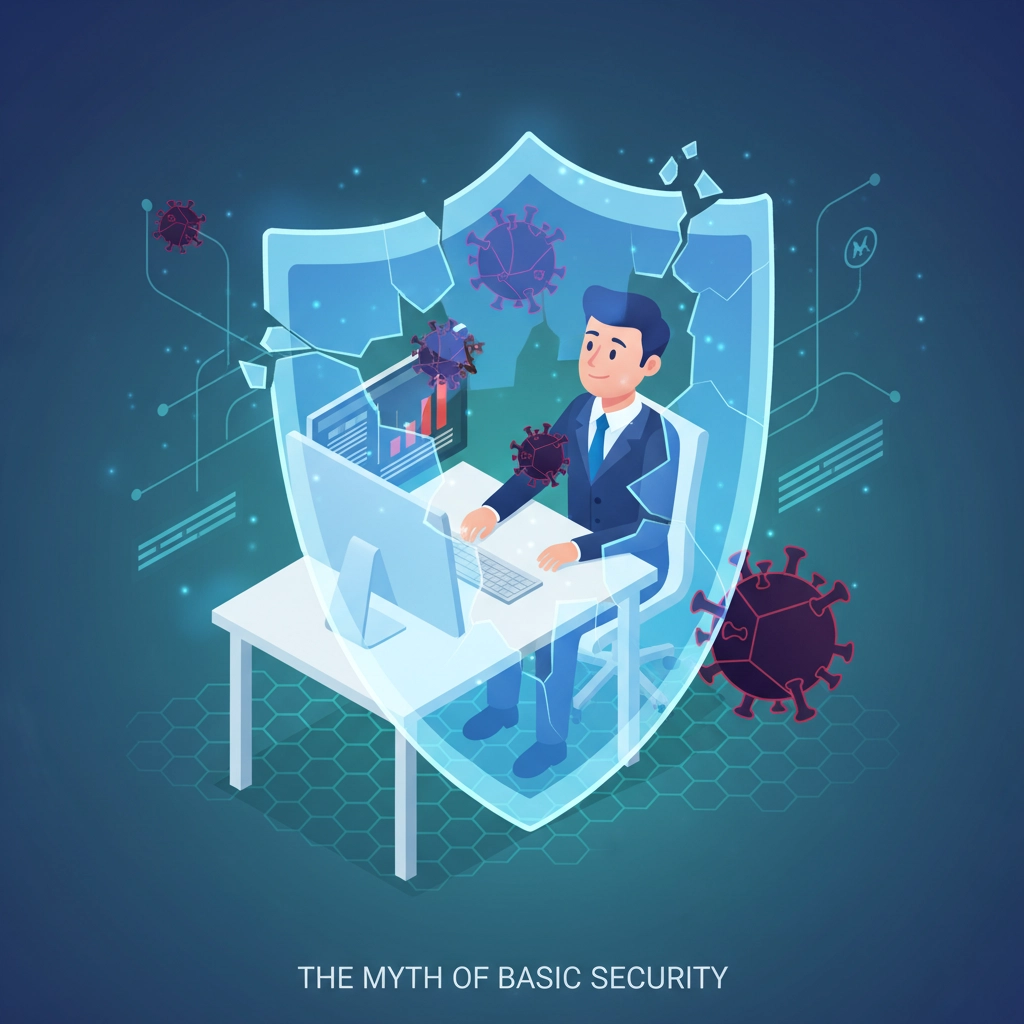Let's cut through the noise: if you think antivirus software is keeping your small business safe in 2025, you're living in a cybersecurity fantasy that could cost you everything.
Here's the harsh reality: 93% of company networks can be penetrated by hackers, and only 14% of small businesses consider their cybersecurity posture highly effective. Meanwhile, 43% of all cyberattacks target small businesses, with devastating consequences: 60% of small businesses that experience a cyber attack go out of business within 6 months.
Those aren't just scary statistics: they're a wake-up call that traditional thinking about cybersecurity is dangerously outdated.
The Biggest Lie in Cybersecurity: "My Antivirus Has Me Covered"
Imagine your business is a house. Traditional antivirus is like having a really good front door lock: it'll stop some burglars, but what about the guy climbing through your bathroom window, the social engineer sweet-talking your receptionist, or the insider who already has the keys?
That's exactly what's happening in cyberspace. Malware represents only 18% of attacks against small businesses. The real threats? Phishing (17%), data breaches (16%), website hacking (15%), and DDoS attacks (12%). Your antivirus isn't designed to stop these.
Even worse, 95% of cybersecurity incidents can be attributed to human error: not technical vulnerabilities that antivirus addresses. When Sarah from accounting clicks that convincing "urgent invoice" email, no antivirus in the world will save you from what happens next.

The Myths That Are Killing Small Businesses
Myth #1: "We're Too Small to Be a Target"
This one makes cybercriminals laugh all the way to the bank. Small businesses receive the highest rate of targeted malicious emails, with 1 in 323 being affected. Here's why you're actually the perfect target:
- You have valuable data (customer info, financial records, intellectual property)
- You have fewer defenses than big corporations
- You're less likely to have dedicated IT security staff
- You often have weaker backup and recovery systems
37% of ransomware attack victims have fewer than 100 employees. You're not flying under the radar: you're painted with a bullseye.
Myth #2: "Basic Security is Good Enough"
The numbers tell a different story:
- Only 17% of small businesses encrypt data
- 53% have over 1,000 unencrypted sensitive folders
- 80% still don't have a formal cybersecurity policy
- 45% lack endpoint protection on company devices
"Basic security" in 2025 is like bringing a butter knife to a gunfight. Cybercriminals are using AI-powered attacks, sophisticated social engineering, and zero-day exploits. Your basic security measures were designed for yesterday's threats.
Myth #3: "Cyber Insurance Replaces Good Security"
Insurance is a safety net, not a security strategy. 91% of small businesses haven't even purchased cyber liability insurance, but even those who have are in for a rude awakening. 83% of small and medium-sized businesses are not prepared to recover from the financial damages of a cyber attack, regardless of insurance coverage.
Plus, cyber insurance costs jumped 28% in 2024 and many policies have exclusions that might leave you high and dry when you need coverage most.
Why These Myths Persist (And Why That's Dangerous)
These dangerous beliefs stick around because:
- Complexity overwhelms – Cybersecurity feels too technical for most business owners
- False confidence – One piece of security software gives a feeling of protection
- Cost concerns – Comprehensive security seems expensive (spoiler: breaches cost way more)
- "It won't happen to me" syndrome – Until it does
But here's the thing: small businesses face cyber attacks every 11 seconds. The question isn't if you'll be targeted: it's when, and whether you'll be ready.

The Real Cost of Wishful Thinking
Let's talk dollars and cents. Small businesses spend between $826 and $653,587 on cybersecurity incidents, with the average cost of a small business data breach reaching $120,000 in 2025.
But the financial impact goes beyond the immediate costs:
- 27% of small businesses with no cybersecurity measures have had customer credit card information stolen
- Lost productivity during downtime
- Reputation damage and customer churn
- Legal fees and regulatory fines
- The cost of forensic investigation and system rebuilding
Ransomware alone costs small businesses an average of $35,000 per incident: and that's just the ransom payment, not counting downtime, lost data, and recovery costs.
What Real Security Looks Like in 2025
Think of cybersecurity like home security. You wouldn't just install a front door lock and call it a day. You'd want:
- Multiple layers of protection (locks, alarms, cameras, lighting)
- Monitoring systems that alert you to problems
- Quick response plans for when something goes wrong
- Regular maintenance to keep everything working
Business cybersecurity works the same way:
Layer 1: Endpoint Protection Beyond Antivirus
Modern endpoint detection and response (EDR) tools that monitor behavior, not just signatures. They catch the sneaky stuff traditional antivirus misses.
Layer 2: Email Security
Advanced email filtering that goes beyond basic spam detection. Since 30% of small business data breaches occur due to stolen credentials often delivered via phishing emails, this is critical.
Layer 3: Network Monitoring
Keeping an eye on what's happening on your network in real-time. Think of it as security cameras for your digital business.
Layer 4: Data Backup and Encryption
If the bad guys get in, encrypted data is useless to them. Regular, tested backups mean you can recover without paying ransoms.
Layer 5: Employee Training
Your people are your first line of defense. 54% of businesses admit their IT departments lack experience to handle complex cyberattacks: training helps fill that gap.

Simple Steps to Get Started Today
Don't let perfect be the enemy of good. Here's what you can do right now:
This Week:
- Enable multi-factor authentication (MFA) on all business accounts
- Update your password policy (or finally create one)
- Schedule automatic updates for all software and operating systems
- Start backing up critical data to the cloud
This Month:
- Conduct a basic security assessment (what devices, what data, what access?)
- Implement basic email security beyond what your email provider offers
- Create an incident response plan (who calls who when things go wrong?)
- Start monthly security awareness training for your team
This Quarter:
- Move beyond basic antivirus to comprehensive endpoint protection
- Encrypt sensitive data at rest and in transit
- Implement network monitoring tools
- Test your backups (seriously: when's the last time you verified they actually work?)
Remember: 97% of businesses expect to increase their cybersecurity budgets in the next 12 months. The question is whether you'll do it proactively or after you've been hit.
The Bottom Line: Wake Up Before It's Too Late
The cybersecurity landscape has fundamentally changed. AI-powered attacks, sophisticated social engineering, and the shift to remote work have made traditional security measures obsolete. 75% of small businesses experienced at least one cyber attack in the past year: are you going to wait to join that statistic?
Your antivirus software is a good start, but it's like wearing only a seatbelt while ignoring the airbags, anti-lock brakes, and collision detection systems. In today's threat environment, that's not cautious: it's reckless.
The good news? You don't have to figure this out alone. Modern cybersecurity solutions are more accessible and affordable than ever, and the cost of comprehensive protection is a fraction of what you'll pay if you get hit.
Ready to move beyond dangerous cybersecurity myths and build real protection for your business? Don't wait for the wake-up call that puts you out of business. Contact B&R Computers today for a no-obligation security assessment: because in cybersecurity, what you don't know really can hurt you.
The next cyber attack happens in 11 seconds. Will your business be ready?




































































































